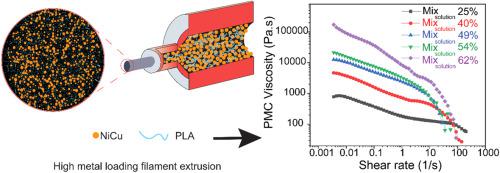Additive Manufacturing ( IF 11.0 ) Pub Date : 2021-03-23 , DOI: 10.1016/j.addma.2021.101967 Amm G. Hasib , Stanislau Niauzorau , Weiheng Xu , Sridhar Niverty , Natalya Kublik , Jason Williams , Nikhilesh Chawla , Kenan Song , Bruno Azeredo

|
3D printing metals via material extrusion utilizes a metal particle reinforced polymer matrix composite (PMC) as the filament which is typically made with gas-atomized powders as fillers. Its rheological behavior limits the maximum metal content of the printed green composite which, consequently, hinders further reductions to part porosity and shrinkage. In this paper, the scaling of the dynamic viscosity of melt-extruded PMC filaments made of PLA and Ni-Cu gas-atomized powders is studied as a function of the metal’s volumetric content and feedstock pre-mixing strategies and correlated to its extrudability performance. Extrudable and uniform filaments with the highest metal content of 63.4 vol% were produced by employing solution-mixing of the PMC feedstock and compared to physical mixing which only reached 54 vol%. After sintering, the improved metal content of 3D printed parts from solution-mixing reduced linear shrinkage by 76% in comparison to physical mixing, resulting in an absolute shrinkage value of 0.49%. By characterizing the PMC feedstock via flow-sweep rheology tests, a distinct extension of the shear-thinning zone towards high shear rates (i.e. 100 s-1) at high metal content was observed for the case of solution-mixed feedstock – a result that is attributed to the improved adhesion of the PMCs to the walls of the rheometer. PMCs with such characteristics correlated well to favorable extrudability and windability test outcomes (i.e. no particle jamming or metal accumulation at the die). The Krieger-Dougherty analytical model was employed to predict the zero-shear rate viscosity as a function of the metal content in the PMCs, however, the latter property is not necessarily correlated to the viscosity at high shear rates (10-1000 s-1) due to a complex shear thinning response. Since PMCs experience high shear rates in the die orifice, additional theoretical models are needed to predict shear-thinning at high metal content in PMCs and, thus, improve our prediction of PMC’s rheology, its design, and extrudability to maximize its metal content.
中文翻译:

散布在热塑性塑料中的球形金属粉末的流变定标及其与3D打印丝的可挤出性的关系
通过材料挤压进行的3D打印金属使用金属颗粒增强的聚合物基复合材料(PMC)作为长丝,通常由气体雾化的粉末作为填充剂制成。其流变行为限制了印刷的生坯复合材料的最大金属含量,因此阻碍了零件孔隙率和收缩率的进一步降低。在本文中,研究了由PLA和Ni - Cu气雾化粉末制成的熔融挤出PMC长丝的动态粘度随金属体积含量和原料预混合策略的变化,并与其可挤出性相关。最高金属含量为63.4的可挤压且均匀的长丝 通过将PMC原料进行溶液混合可以生产50%(体积),而物理混合仅达到54 %(体积)。烧结后,与物理混合相比,固溶混合提高了3D打印零件的金属含量,使线性收缩率降低了76%,因此绝对收缩率值为0.49%。通过流变流变学测试表征PMC原料,剪切稀化区向高剪切速率(即100 s -1)的明显扩展)在溶液混合的原料中观察到高金属含量-这归因于PMC与流变仪壁的粘附性得到了改善。具有此类特性的PMC与良好的可挤出性和可卷绕性测试结果密切相关(即,在模头上没有颗粒堵塞或金属积聚)。使用Krieger-Dougherty分析模型来预测零剪切速率粘度随PMC中金属含量的变化,但是,后者的特性并不一定与高剪切速率(10-1000 s -1)下的粘度相关)是由于复杂的剪切变稀响应。由于PMC在模孔中经历高剪切速率,因此需要额外的理论模型来预测PMC中高金属含量时的剪切稀化,从而改善我们对PMC流变学,其设计和可挤出性的预测,以最大程度地提高其金属含量。

























 京公网安备 11010802027423号
京公网安备 11010802027423号